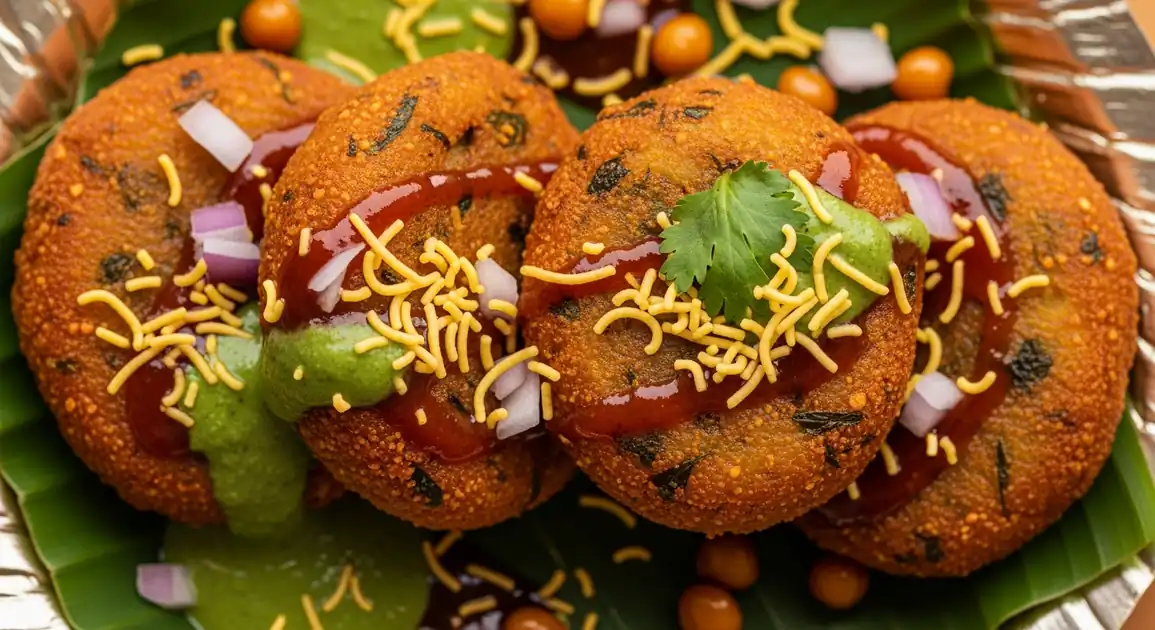Aloo Tikki (Potato Patties)
आलू टिक्की

Description
Delhi is widely considered the spiritual home of Aloo Tikki, with countless vendors across the city offering their unique versions. From the historic streets of Old Delhi to the modern markets of South Delhi, the capital city elevates this humble potato patty to an art form with perfect spicing, crisp textures, and an elaborate array of accompaniments.
Dietary Information
Serving information
Serving style
Delhi-style typically involves smashing the tikki slightly before topping it with yogurt and chutneys. Often served on small disposable plates or dona (leaf bowls), eaten with wooden or plastic spoons provided by the vendor.
Quick facts
Street vendors typically operate 12 PM - 10 PM, with established shops sometimes open from 10 AM - 10 PM.
Safety Tips
What to Look For
-
Patties fried thoroughly until golden-brown on both sides
Proper cooking ensures food safety by reaching temperatures that kill harmful bacteria. Undercooked pale tikkis may contain unsafe bacteria.
-
Hot, actively sizzling griddle (tawa)
A properly heated cooking surface ensures the tikkis cook thoroughly and crisp up properly.
-
Fresh chutneys that look vibrant
Fresh green chutney should be bright green, not brown or discolored, indicating it was prepared recently.
-
Covered ingredients and clean preparation area
Ingredients should be protected from flies and dust. The vendor's station should appear organized and relatively clean.
-
High customer turnover
Popular stalls typically serve fresher food as they prepare ingredients more frequently throughout the day.
What to avoid
-
Pre-fried tikkis sitting at room temperature
Tikkis should be fried fresh to order. Pre-fried patties sitting out can harbor bacteria, especially when topped with yogurt and chutneys.
-
Pale or undercooked patties
Tikkis should be golden-brown and crisp, not pale or soft, ensuring they've been cooked to food-safe temperatures.
-
Uncovered or visibly spoiled chutneys and yogurt
Dairy products and wet chutneys are particularly prone to spoilage in warm weather. They should look fresh and be stored properly.
-
Vendors who handle money and food without washing hands
Cross-contamination can introduce harmful bacteria. Good vendors use separate people for handling money or wash hands between tasks.
-
Reused oil that appears very dark or smells rancid
Quality vendors change their cooking oil regularly. Very dark, smoky oil can indicate poor practices and affect both safety and taste.
Price information
Price range
Budget tips
- Traditional Old Delhi vendors offer the best value (20-40 INR).
- Karol Bagh and Lajpat Nagar markets have affordable options (30-50 INR).
- Modern food court versions in malls cost 60-120 INR.
- Look for 'student special' offers near Delhi University areas.
Value indicators
- Hand-formed tikkis rather than pre-made.
- Both green (mint-coriander) and sweet (tamarind) chutneys offered.
- Freshly prepared yogurt topping.
- Generous garnish of sev and spices.
- 'Desi ghee' (clarified butter) used for frying at premium stalls.
Where to Find This Dish
Old Delhi / Chandni Chowk
Historic hub with some of the most renowned aloo tikki vendors, especially around Paranthe Wali Gali.
Chandni Chowk Metro Station, Jama Masjid, Red Fort periphery
Afternoon, Evening
Connaught Place
Central Delhi's shopping district with both street vendors and established food stalls.
Janpath Market, Central Park, Inner Circle
Afternoon, Evening
Karol Bagh
Popular shopping area with numerous tikki stalls, especially around Ajmal Khan Road.
Karol Bagh Metro Station, Ajmal Khan Road
Evening
Lajpat Nagar
South Delhi market known for street food, particularly in Central Market area.
Lajpat Nagar Central Market, Lajpat Nagar Metro Station
Evening
Delhi University North Campus
Budget-friendly student favorites around Kamla Nagar and Hudson Lane.
Vishwavidyalaya Metro Station, Kamla Nagar Market
Afternoon, Evening
Vendor Tips
- Some of Delhi's most famous vendors include Amit Aloo Tikki (Lajpat Nagar) and Nand Di Hatti (Sadar Bazar).
- Request 'special toppings' for extras like pomegranate seeds or unique chutneys at some stalls.
- For authentic experience, try the versions in Old Delhi that follow recipes passed down for generations.
- Delhi-style tikkis are typically spicier - specify 'kam teekha' (less spicy) if needed.
How to Order
Regional Variations
-
Old Delhi Style
(पुरानी दिल्ली स्टाइल)
Characterized by generous use of spices, particularly cumin and coriander, with a slightly thicker patty. Often served with extra yogurt and a sprinkle of rock salt (kala namak).
-
Punjabi Influence
(पंजाबी प्रभाव)
Found in West Delhi areas with large Punjabi populations, features more ghee, larger tikkis, and often includes a stuffing of spiced peas (matar).
-
Modern Delhi Fusion
(आधुनिक दिल्ली फ्यूज़न)
Contemporary vendors, especially in South Delhi and Gurgaon, offer innovative versions with cheese, corn, paneer stuffings, or fusion toppings like salsa.
-
Delhi University Campus Style
(दिल्ली विश्वविद्यालय कैंपस स्टाइल)
Budget-friendly versions popular with students, typically larger in size but simpler in toppings, often served as a tikki burger or with extra potato portions.
Cultural context
History
Aloo Tikki has its roots in North Indian cuisine, particularly in Delhi and the Punjab region. The word 'tikki' comes from the Sanskrit 'tukkā' meaning small pieces. While potato patties have been part of Indian cuisine for centuries, the modern street food version evolved in the bustling lanes of Old Delhi, where vendors perfected the art of creating crispy exteriors while maintaining soft, flavorful interiors. It represents India's ingenious use of affordable ingredients to create deeply satisfying food accessible to all.
Local significance
Aloo Tikki is emblematic of Delhi's renowned street food culture and represents the city's Punjabi and Mughlai culinary influences. It's considered one of the city's signature chaats, alongside golgappa and papri chaat.
Eating customs
- Delhi-style typically involves crushing the tikki slightly before adding toppings.
- Locals often specify the amount of spice and yogurt according to preference.
- Traditionally followed by something sweet like jalebi to balance the meal.